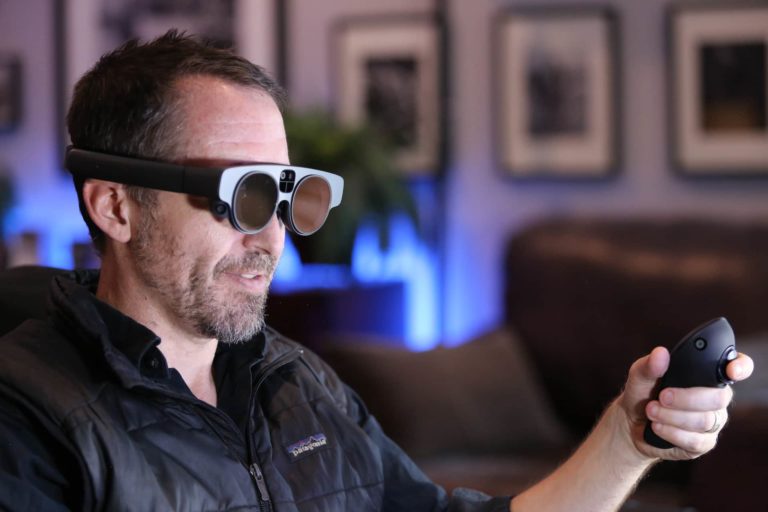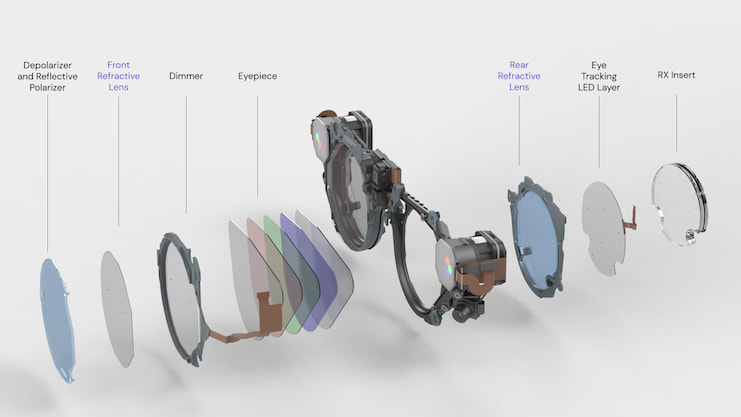
After an eventful 12 years – including ample funding, big promises, a quasi-fall from grace, and an executive reshuffle – Magic Leap is in the midst of a notable turnaround. This includes new leadership in Peggy Johnson and a corresponding follow-the-money pivot to enterprise AR.
But among the components of Magic Leap’s return to the tech world’s good graces, most notable could be its second swing at AR glasses. Magic Leap 2 (ML2) launches later this month with purpose-built features for enterprise endpoints, and to fill some gaps left by its predecessor.
Specifically, the device will be widely available on September 30 at three price points. These include a $3,299 “Base” package (headset plus limited warranty), a $4,099 “Developer Pro” (added development software), and a $4,999 “Enterprise” package (device management tools).
To prime the launch and offer a first-hand look, Magic Leap invited us to try ML2 for a few weeks. And below is our take. But fair warning: our hardware observations usually eschew the common spec-heavy review style (though there’s some of that) in favor of market-positioning analysis.
Practical Outcome
One of the headlines for ML2 is its upgraded optics and display system. The field of view (FOV) is 2x that of Magic Leap 1, while its architecture achieves 12x more efficient light distribution. It also features 2,000 nits of brightness with 2x image quality and 2-3x color uniformity,
Taking those one at a time, the FOV is the first thing you may notice when firing up the device. The 70-degree diagonal FOV feels considerably less confined than ML1’s 50 degrees. The practical outcome, beyond sentiments of the review corps, is broader potential use cases.
A few that come to mind include multiple colleagues collaborating on virtual content from different angles. Physicians can get full-body patient views. And front-line industrial workers can gain a more complete sense of large and complex machinery when servicing them.
To that end, Magic Leap says that it will continue to achieve step-function improvements in FOV and optical efficiency. It projects (without committing to specifics) that 80+ degree FOV will be possible in Magic Leap 3, with 50 percent smaller volume in its projector and integrated stack.
Living Daylights
As for brightness, 2000 nits is a solid milestone, but it’s not enough to compete with direct sunlight. Outdoor use is a key design target, which will further broaden ML2’s applicability and thus addressable market. But simply amping up the brightness has tradeoffs (power & heat).
This is where ML2’s signature dimming feature comes in. In short, it reduces incoming light so that graphical elements can achieve higher contrast and brightness. This counteracts one of AR glasses’ ongoing challenges that plagues almost everyone: washed-out graphics.
Here, dimmers are integrated into Magic Leap 2’s optical stack. And it comes in two flavors: global and segmented dimming. The former dims the entire environment, while the latter dims parts of the display that include digital elements. These collectively address a range of use cases.
For example, global dimming is useful for entertainment or personal productivity. That could include things like virtual monitors. Segmented dimming is optimal when you need to see your surroundings in full light, such as industrial scenarios that involve guided assembly.

To Infinity
Another common challenge with AR glasses is wearability and comfort. Magic Leap 2 addresses this with better ergonomics and total weight (260 grams). But comfort can also happen on other levels, which brings us back to improvements in Magic Leap 2’s optical stack.
Specifically, Magic Leap 2 takes steps to address AR’s vergence accommodation conflict. For those unfamiliar, this happens when wearing AR glasses and your eyes naturally focus on real objects. But virtual objects that aren’t rendered at the correct distance appear out of focus.
Magic Leap 1 addressed this issue by using two focal planes which added to the device’s bulk. ML2 conversely starts over with a series of factors including eye tracking with two interior cameras. These translate pupil dilation to accurate image rendering and focal matching.
The result is the ability to comfortably view and dynamically switch focus on content ranging from 37 centimeters to infinite distances (in focal depth terms). This will be useful in reducing eye strain in high-value use cases such as, again, industrial assembly and maintenance.
Deliberate Distances
So far, everything above focuses (excuse the pun) on ML2’s optical improvements. And rightly so: visuals are a primary element in all-things AR. But for holistic sensory immersion – especially in enterprise use cases – another sensory input is often critical: sound.
This is where spatial audio factors in – one of ML2’s biggest selling points. It simulates spatial positioning so that sounds are perceived at deliberate distances and directions. For example, something requiring attention to your right sounds like it’s coming from that direction.
Without getting too technical, ML2 achieves this by directing sound waves to each ear in a way that utilizes the human auditory system’s ability to triangulate audio signals. This is similar to the way our vision perceives depth with two eyes. Two ears do something similar.
And like many of the features examined above, spatial audio has practical outcomes and use cases. For example, virtual meetings can mimic physical spaces like a conference room, with realistic sound fields. Industrial applications can divert users’ attention directionally.
Don’t Call it a Comeback
Coming full circle to Magic Leap’s turnaround, ML2 sits at the center. And several other components of that road map influence the device’s design. For example, OpenXR and WebXR support – not to mention an Android-based OS – ease adoption barriers for developers.
But another aspect of Magic Leap’s current positioning falls outside of ML2…or anything deliberate for that matter. The company’s resurgence happens as headwinds challenge its chief competitor: Microsoft. The last year has seen some erosion to its enterprise AR dominance.
That involves a few factors including turbulence in its landmark U.S. Army contract, internal disagreement about HoloLens 2’s strategic importance, and the high-profile departure of HoloLens creator Alex Kipman. These things have set Microsoft’s AR ambitions back a bit.
Without disparaging Microsoft or piling on the grief, we mention this only to say that the timing is opportune for a HoloLens 2 competitor. That plus new leadership with competency in enterprise sales clears the path for Magic Leap’s market-share gains. Now it’s all about execution.
Stay tuned for part II of our ML2 analysis where we’ll zero in on privacy and security implications.

